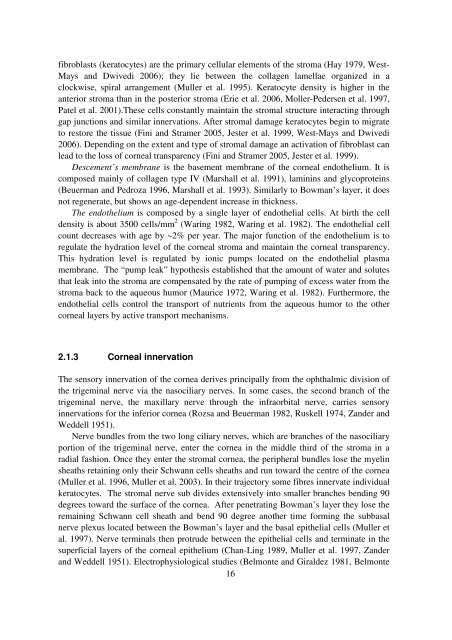Excimer laser refractive surgery : corneal wound ... - Helda - Helsinki.fi
Excimer laser refractive surgery : corneal wound ... - Helda - Helsinki.fi
Excimer laser refractive surgery : corneal wound ... - Helda - Helsinki.fi
Create successful ePaper yourself
Turn your PDF publications into a flip-book with our unique Google optimized e-Paper software.
<strong>fi</strong>broblasts (keratocytes) are the primary cellular elements of the stroma (Hay 1979, West-<br />
Mays and Dwivedi 2006); they lie between the collagen lamellae organized in a<br />
clockwise, spiral arrangement (Muller et al. 1995). Keratocyte density is higher in the<br />
anterior stroma than in the posterior stroma (Erie et al. 2006, Moller-Pedersen et al. 1997,<br />
Patel et al. 2001).These cells constantly maintain the stromal structure interacting through<br />
gap junctions and similar innervations. After stromal damage keratocytes begin to migrate<br />
to restore the tissue (Fini and Stramer 2005, Jester et al. 1999, West-Mays and Dwivedi<br />
2006). Depending on the extent and type of stromal damage an activation of <strong>fi</strong>broblast can<br />
lead to the loss of <strong>corneal</strong> transparency (Fini and Stramer 2005, Jester et al. 1999).<br />
Descement’s membrane is the basement membrane of the <strong>corneal</strong> endothelium. It is<br />
composed mainly of collagen type IV (Marshall et al. 1991), laminins and glycoproteins<br />
(Beuerman and Pedroza 1996, Marshall et al. 1993). Similarly to Bowman’s layer, it does<br />
not regenerate, but shows an age-dependent increase in thickness.<br />
The endothelium is composed by a single layer of endothelial cells. At birth the cell<br />
density is about 3500 cells/mm 2 (Waring 1982, Waring et al. 1982). The endothelial cell<br />
count decreases with age by ~2% per year. The major function of the endothelium is to<br />
regulate the hydration level of the <strong>corneal</strong> stroma and maintain the <strong>corneal</strong> transparency.<br />
This hydration level is regulated by ionic pumps located on the endothelial plasma<br />
membrane. The “pump leak” hypothesis established that the amount of water and solutes<br />
that leak into the stroma are compensated by the rate of pumping of excess water from the<br />
stroma back to the aqueous humor (Maurice 1972, Waring et al. 1982). Furthermore, the<br />
endothelial cells control the transport of nutrients from the aqueous humor to the other<br />
<strong>corneal</strong> layers by active transport mechanisms.<br />
2.1.3 Corneal innervation<br />
The sensory innervation of the cornea derives principally from the ophthalmic division of<br />
the trigeminal nerve via the nasociliary nerves. In some cases, the second branch of the<br />
trigeminal nerve, the maxillary nerve through the infraorbital nerve, carries sensory<br />
innervations for the inferior cornea (Rozsa and Beuerman 1982, Ruskell 1974, Zander and<br />
Weddell 1951).<br />
Nerve bundles from the two long ciliary nerves, which are branches of the nasociliary<br />
portion of the trigeminal nerve, enter the cornea in the middle third of the stroma in a<br />
radial fashion. Once they enter the stromal cornea, the peripheral bundles lose the myelin<br />
sheaths retaining only their Schwann cells sheaths and run toward the centre of the cornea<br />
(Muller et al. 1996, Muller et al. 2003). In their trajectory some <strong>fi</strong>bres innervate individual<br />
keratocytes. The stromal nerve sub divides extensively into smaller branches bending 90<br />
degrees toward the surface of the cornea. After penetrating Bowman’s layer they lose the<br />
remaining Schwann cell sheath and bend 90 degree another time forming the subbasal<br />
nerve plexus located between the Bowman’s layer and the basal epithelial cells (Muller et<br />
al. 1997). Nerve terminals then protrude between the epithelial cells and terminate in the<br />
super<strong>fi</strong>cial layers of the <strong>corneal</strong> epithelium (Chan-Ling 1989, Muller et al. 1997, Zander<br />
and Weddell 1951). Electrophysiological studies (Belmonte and Giraldez 1981, Belmonte<br />
16

















